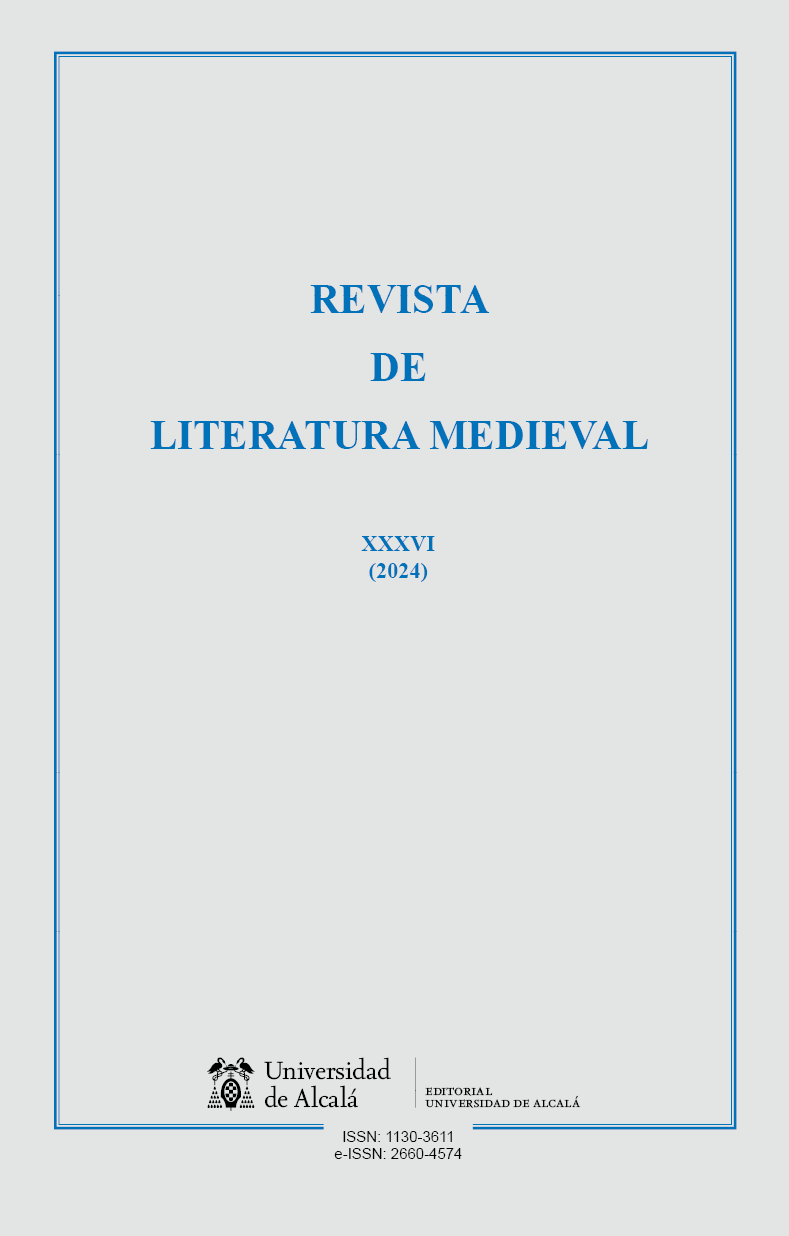A satire against person and mores in a vilancete followed by trovas and cantiga in Garcia de Resende’s Cancioneiro geral
DOI:
https://doi.org/10.37536/RLM.2024.36.1.101071Keywords:
Garcia de Resende’s Cancioneiro Geral, Satire at person, Satire at mores, Mixed-forms poems, Metrics, RhetoricAbstract
Satire can be said to be timeless, as it is present at any time and in any genre. In the mixed-forms poem analyzed in this article, the satire is directed at a courtier who, upon his return from Spain to Portugal, is wearing an enormous cap, which provokes ridicule and scorn from other courtiers. The poem criticizes not only a person, but also the mores. As a poetic form, it begins with a ‘vilancete’ followed by ‘trovas’ and ends with a ‘cantiga’. The unfortunate Lopo de Souza will hear more than thirty contemporary poets sucking on verses from his disproportionate cap, which, in addition to being too large, has velvet for its cloth, which does not suit the season of the year, summer. The poem is rich in structural devices such as meter, rhyme, ‘pés quebrados’ and rhythm; it is also rich in rhetorical resources, as can be seen in this article.
Downloads
Métricas alternativas
References
Alberti, Verena (2002), O riso e o risível: na história do pensamento. Rio de Janeiro: Jorge Zahar Ed. (Coleção Antropologia Social).
Beltran, Vicenç (2016), «La canción», en Fernando Gómez Redondo (dir.), Historia de la métrica medieval castellana. San Millán de la Cogolla: Cilengua, pp. 542-558.
Beltran, Vicenç (2018), «Un cancionerillo jocoso o casi burlesco (MP2/TP2): la poesía castellana en el arbor del siglo xvi», in Andrea Zinato e Paola Belloni (org.), Poesía, poéticas y cultura literaria. Como/Pavia: Ibis, pp. 93-123.
Chas Aguión, Antonio y Álvarez Ledo, Sandra (2016), «Los decires», en Fernando Gómez Redondo (dir.), Historia de la métrica medieval castellana. San Millán de la Cogolla: Cilengua, pp. 649-667.
Dias, Aida Fernanda (1998), «A Temática», Cancioneiro Geral de Garcia de Resende. Maia: Imprensa Nacional/Casa da Moeda. Vol. V.
Dias, Aida Fernanda (2003), Cancioneiro Geral de Garcia de Resende – Dicionário (Comum, Onomástico e Toponímico). Maia: Imprensa Nacional/Casa da Moeda, vol. VI.
Mongelli, Lênia Márcia de Medeiros (org.) (2009), Fremosos Cantares. Antologia da lírica medieval galego-portuguesa. São Paulo: WMF Martins Fontes.
Gomes, João Carlos Teixeira (1985), Gregório de Matos, o boca de brasa. Um estudo de plágio e criação intertextual. Petrópolis: Editora Vozes.
González Cuenca, Joaquín (2004), in Hernando del Castillo, Cancionero General. Madrid: Ed. Castalia, T. I-V.
Moisés, Massaud (2004), Dicionário de termos literários. Massaud Moisés (org.). São Paulo: Cultrix.
Moráen Cabanas, M.ª Isabel (2001), Traje, Gentileza e Poesia. Moda e Vestimenta no Cancioneiro Geral de Garcia de Resende. Lisboa: Ed. Estampa (Colecção Leituras, 9).
Gómez Redondo, Fernando (dir.) (2016), Historia de la métrica medieval castellana. San Millán de la Cogolla: Cilengua.
Riquer, Martín de (2001), Los trovadores. Historia literaria y textos. Barcelona: Ed. Ariel. T. I e II.
Sá Rego, Enylton José (1989), O calundu e a panaceia. Machado de Assis, a sátira menipéia e a tradição luciânica. Rio de Janeiro: Forense Universitária.
Sodré, Paulo Roberto (2010), O riso no jogo e o jogo no riso na sátira galego-portuguesa. Vitória: EDUFES.
Tato, Cleofé (2018), «Los comienzos del género del mote en la poesía de cancionero», in Andrea Zinato e Paola Belloni (org.), Poesía, poéticas y cultura literaria. Como/Pavia: Ibis, pp. 277-294.
Tomassetti, Isabella (2016), «El villancico», en Fernando Gómez Redondo (dir.), Historia de la métrica medieval castellana. San Millán de la Cogolla: Cilengua, pp. 558-581.
Published
How to Cite
Issue
Section
License
Copyright (c) 2024 GERALDO AUGUSTO FERNANDES

This work is licensed under a Creative Commons Attribution-NonCommercial-ShareAlike 4.0 International License.
The opinions and facts stated in each article are the exclusive responsability of the authors. The University of Alcalá is not responsible in any case for the credibility and aunthenticity of the studies.
Authors will retain the rights on their work, even if they will be granting the journal a non-exclusive right of use to reproduce, edit, distribute, publicly communicate and show their work. Therefore, authors are free to enter into additional, independent contracts for non-exclusive distribution of the works published in this journal (such as uploading them to an institutional repository or publishing them in a book), as long as the fact that the manuscripts were first published in this journal is acknowledged.
Works are published under the terms stipulated in the Attribution-NonCommercial-ShareAlike 4.0 International License (CC BY-NC-SA 4.0) that allows third parties to share the work under the following conditions:
Attribution — You must give appropriate credit, provide a link to the license, and indicate if changes were made. You may do so in any reasonable manner, but not in any way that suggests the licensor endorses you or your use.
NonCommercial — You may not use the material for commercial purposes.
ShareAlike — If you remix, transform, or build upon the material, you must distribute your contributions under the same license as the original.









